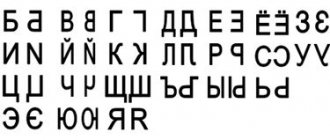When a child begins to study in primary school, parents may be surprised to learn from the teacher that their child is experiencing serious difficulties with writing. Quite often, a new student makes many specific mistakes when writing words and, despite all his efforts, completes written assignments extremely slowly and sloppily. This is how a specific speech therapy pathology manifests itself – dysgraphia.
How to understand that a child has dysgraphia?
At its core, dysgraphia is a fairly common speech therapy defect in which written speech is impaired. This deviation is diagnosed in almost 30% of students. The presence of pathology in younger schoolchildren is associated with insufficient maturity of the mental system, as well as with a lack of consistency in the functioning of the brain lobes, which are responsible for the perception of information and fine motor skills of the hands.
Most often, the presence of dysgraphia is detected precisely at the beginning of schooling, when purposeful mastery of these skills occurs. In copybooks, the child makes phonetic errors of various types.
For example, it does not distinguish between letters that sound similar (“z” and “s”, “zh” and “sh”, “t” and “d”), adds unnecessary ones or skips necessary ones (“vesena” instead of “spring”, “trlka” " instead of "plate"), writes words together, etc.
At first, looking at the work of such a student, the teacher can conclude that he is lazy, irresponsible or illiterate. However, the reason lies much deeper. Such children diligently approach the task, however, for certain reasons, they cannot cope with the correct spelling of words.
For example, if we compare the mistakes of two students in writing the word “sentence”, then a child with simple ignorance of grammatical rules will write “addition”, and a child with dysgraphia will write “branching”. It is in such nuances that the presence of this pathology is visible.
Moreover, as a rule, dysgraphics are written very sloppy and crookedly. No matter how hard they try, they cannot keep up with their faster classmates, which causes constant irritability, dissatisfaction, depressed mood and low self-esteem. Moreover, quite often dysgraphia is supplemented by dyslexia (difficulties with reading) and speech disorders.
Dyscalculia
A disorder characterized by an inability to learn and understand arithmetic operations, as well as an inability to operate with numbers and figures.
This syndrome is considered as a specific neurological and neuropsychological disorder.
There are seven types of dyscalculia:
1. Graphic
- inability to correctly write down a heard number, define a mathematical term, or depict a geometric figure;
2. Verbal
- inability to correctly name a number, symbol, or indicate the number of objects;
3. Lexical
- lack of understanding of mathematical operations, inability to perform tasks due to lack of understanding of the essence of operations, disturbance in spatial-visual processes;
4. Operating room
- inability to perform mathematical operations;
5. Practognostic
- lack of ability to abstractly count objects, distribute objects depending on characteristics such as quantity, shape, size, etc.
6. Arithmery
- inability to learn to calculate;
7. Pseudodyscalculia
- decrease in mathematical abilities due to reluctance to learn, lagging behind in the curriculum, illiterate learning process.
Dyscalculia is an independent disease that has been much less studied than dyslexia and dysgraphia. This violation should not be perceived as laziness.
Correction of dyscalculia is individual and difficult to predict in a time frame. Like any violation, counting violations should be corrected promptly and systematically. This pathology must be identified in the child’s preschool age, otherwise its correction becomes a very difficult and lengthy process.
Correction of dyscalculia should be combined with the development of speech in the child. There should be an expansion of the vocabulary, including mathematical terms.
Main types of dysgraphia
Based on the characteristics of written disorders, experts identify five main types of dysgraphia. Let's take a closer look at how each of them manifests itself.
Acoustic dysgraphia
The child pronounces words correctly and does not experience hearing difficulties, however, when displaying information on paper, he replaces letters with ones that sound similar to them. These can be vowels or consonants, voiced or unvoiced, hissing or whistling. The student may also have difficulty representing letters correctly in soft form.
For example: “dikdand” - “dictation”, “masina” - “car”, “syplenok” - “chicken”, as well as “lublu” - “love”, “frock coat” - “frock coat”.
Articular-acoustic dysgraphia
Problems with spelling words are the result of incorrect pronunciation. A child who has speech therapy defects and makes mistakes during a conversation cannot correctly transfer sounds onto paper. That is, as the student speaks, so he writes. Accordingly, if the baby has incorrect pronunciation, then the spelling will be the same. For example: “lyba” - “fish”, “labota” - “work”, “zayas” - “hare”, “sapka” - “hat”, “nasa skola” - “our school”.
Optical dysgraphia
The child has difficulty visually representing written characters. The student can assign additional details, loops, ticks or hooks to the letters, or lose the necessary elements. Mirror spelling of letters is also quite often observed, especially in cases where the student is left-handed.
Example: most often a child confuses the spelling of similar letters “i” - “sh”, “o” - “a”, loses elements of the symbols “” - “A” or displays them in a mirror image “E” - “Z”.
DYGRAPHIA - DYSLEXIA
- home
- Speech therapy
- DYGRAPHIA - DYSLEXIA
>
>
Written speech consists of two types of speech activity - writing and reading.
Dysgraphia and dyslexia are the inability (or difficulty) of mastering writing and reading with intact intelligence and physical hearing.
Most often, dyslexia and dysgraphia are observed in a child at the same time, but sometimes they can occur in isolation. Complete inability to read is alexia, complete inability to write is agraphia. Writing is one of the most difficult human activities and learning to write is not as easy as it seems.
A letter begins with an idea. You need to mentally create a plan for a written statement, determine the general sequence of thoughts and constantly maintain it. Each sentence that needs to be written must be divided into its constituent words, since the boundaries of each word are indicated in writing. To write a word correctly, it is necessary to determine its sound structure, the sequence and place of each sound. In the initial stages of mastering writing, it is important to pronounce every word. Pronunciation (loud, whispered or internal) helps to clarify the nature of the sound, distinguish it from similar sounds, and determine the sequence of sounds in a word.
The next operation is that the phoneme isolated from a word must be correlated with a certain visual image of the letter. Letters, like sounds, have elements of instability. In terms of its outline, any letter can be very different: large and small, pointed, round, curved. A letter does not resemble itself depending on what, what color and on what surface it was written. To learn to write and read, you need vision for letters - letter gnosis. By analogy with phonemic hearing, letter vision could rightfully be called graphematic. It is this vision that isolates from the letters the stable features hidden in them, the elements that distinguish one letter from another. Analyzing and comparing letters is a difficult task for a first grader.
Then the child must reproduce the visual image of the letter using hand movements. Simultaneously with the movement of the hand, kinesthetic control is carried out. As letters and words are written, kinesthetic control is reinforced by visual control and reading what is written. At the beginning of learning to write, children focus their attention on many details that characterize the spatial orientation of movements and the graphic correctness of execution (“where to start, where to lead, where to end”). Each element at this stage is written out separately, even if the school requires you to write the entire letter or several letters at once. The child constantly controls what he is doing and thinks about what and how to do next. It takes the same amount of time to realize the action and determine the strategy for subsequent action as it does to perform the movement itself.
The lack of formation of any operation that ensures the process of writing or reading can lead to certain difficulties in learning to read and write, causing dysgraphia or dyslexia. The causes of reading and writing disorders are similar. Depending on which operation is impaired, different forms of dyslexia and dysgraphia are distinguished.
Forms of dyslexia and dysgraphia
In modern speech therapy, there are several approaches to the classification of dysgraphia and dyslexia. There is no generally accepted classification, and in practice, speech therapists hold different views on the causes of writing and reading defects and the problems of their development, most often focusing on the work of those specialists who belong to the same scientific school as them.
Phonemic dyslexia and dysgraphia
The most common are phonemic dyslexia and dysgraphia (acoustic in traditional terminology). Almost all authors describe it under different names. Children with this form of dysgraphia have difficulty hearing the sound of a word. They are poorly oriented in the sound of words, the sounds of speech are confused, merge with each other in words, and the words themselves often merge with each other. Audible speech is poorly perceived. And for correct writing, subtle auditory differentiation of sounds and analysis of all acoustic semantic distinctive features of sound are necessary. Phonemic dysgraphia manifests itself in writing in the substitution of letters corresponding to phonetically similar sounds. The child writes not what he is told, but what he heard. The word "brush" is spelled like "rosary", the words "copy" and "spears" sound and are written the same. A common mistake is replacing vowels even in the stressed position. The child understands some things exactly, but some things very approximately. Difficulties also arise when mastering spelling rules, since the child does not hear all the sound changes when words are grammatically changed, does not make the necessary generalizations, and does not feel the connections between words. Errors also occur when reading: children confuse letters, miss consonants when they come together, rearrange syllables, read by guess.
Optical dyslexia and dysgraphia
Optical dyslexia and dysgraphia (visual in other terminology) are caused by instability of visual impressions and ideas. To learn to read and write, one needs vision for letters—letter gnosis. A letter differs from any other drawing primarily in its convention; it is in no way connected in meaning with the sound that it denotes. In the history of mankind, letters have acquired such great importance that in the brain, in its left hemisphere, a special area has been allocated that is responsible for the letter. Violation of letter gnosis and spatial concepts is manifested in difficulties in mastering letters, their substitutions and distortions in writing and reading. Letters that are similar in design (Z - E, R - L), letters that differ in additional elements (L - D, Z - V), letters consisting of identical, but differently located elements in space (N - P - I) are mixed and interchanged , T – G). Children who have difficulty remembering a letter visually may reverse the letter, skip it, or add an extra hook. Optical dysgraphia also includes mirror reversals of letters. Mirror writing is more common in left-handed people, who can read, write, and copy a letter, number, or word equally likely in any direction.
Kinetic (motor) dyslexia and dysgraphia
Not all authors identify this form of written language impairment as an independent form. However, many people note disturbances in eye movements during reading (oculomotor dyslexia). A fixed gaze practically does not perceive an image with a complex structure. Any complex perception is carried out with the help of active, searching movements of the eye. The translation of the gaze from letter to letter, from word to word, from line to line has its own patterns. Children do not always manage to master them without hindrance. Kinetic (motor) dysgraphia is caused by certain requirements for hand movement; if they are not met, characteristic difficulties in hand movement during writing arise.
Dysorphography
There is also no consensus on the legality of classifying dysorthography as dysgraphia. This is currently the least studied category of writing disorders. It is believed that with dysorthography, a child lacks a “sense” for spelling; he can make from 15 to 60 errors on a page. The child cannot determine where exactly the rule that is well known to him needs to be applied; he cannot detect an error, much less correct it. In other words, “he knows the rules, but cannot apply them.” Detecting spelling patterns and solving a spelling problem requires mastery of morphological analysis of words, sufficient vocabulary, and the ability to select the necessary test words based on formal grammatical features. Difficulties in mastering spelling skills are noted not only in the initial period of education, but also in middle and high school. The most common mistakes are on the rules that are studied in elementary school. A special type of dysorthography is a persistent inability to master syntactic rules in writing, i.e. punctuation. Children with dysorthography especially need speech therapy help. Without it, they often find themselves among the underachievers in all subjects.
Secondary (nonspecific) dyslexia and dysgraphia.
All these types of dysgraphia are primary, because are caused by a violation of one of the basic prerequisites for written speech. A distinctive feature of secondary reading and writing disorders is the absence of specific prerequisites for them. Such children easily differentiate phonemes, navigate the sound-letter analysis of a word, recognize complex visual images, and have no restrictions in movements. In the occurrence of secondary dyslexia and dysgraphia, a significant role is played by deficits in voluntary concentration, switching and distribution of attention. Poor auditory-verbal memory makes it difficult to remember a read or dictated text and reproduce it correctly. The pace of activity during writing and reading is of particular importance. Children who, for some reason, do not have time to write and read at a given pace, in a hurry to complete the task, make a wide variety of mistakes. You might think that they have all types of dyslexia and dysgraphia at once. However, when the pace slows down, these children read and write quite well.
Every child should learn to write and read.
Many children fail to cope with this task.
How can I help them?
AT THE HEALTHY CHILD CENTER A Speech Pathologist WILL HELP YOU COPE WITH THESE DIFFICULTIES!
Is it possible to eliminate dysgraphia in a child?
Dysgraphia is a defect that can be corrected. Children with this pathology successfully develop, grow up and achieve success. This can be confirmed by famous people who were diagnosed with dysgraphia in childhood, including Albert Einstein, Walt Disney, Marilyn Monroe, Vladimir Mayakovsky and many others.
The key task of the parents of such a child is to attract a competent speech therapist-defectologist to solve this problem. A correction course is developed after determining the type of dysgraphia and the severity of the pathology. The speech therapist creates exercises that allow you to compensate for defects in the pronunciation of sounds, correct speech, form the recognition of sounds and letters, develop motor skills and other mental functions of the child.
Date of publication: 02/25/2019. Last modified: 05/05/2021.
Causes of acoustic dysgraphia
The occurrence of acoustic type dysgraphia is based on a violation of phonemic hearing and perception. They help to correctly recognize the sound structure of a word, determine the number of syllables, the location and exact meaning of the phoneme.
Zones located in the temporal regions of the brain are responsible for differentiating sound images of words. It is here that the acoustic signal is encoded and transmitted to Wernicke's area, where the received information is analyzed and synthesized. Violations that arise in these zones lead to incorrect phonetic perception.
The causes of violations can be various factors:
- Intrauterine lesions of the fetal brain.
- Infections during pregnancy.
- Serious illnesses of a child at an early age.
- Social or psychological reasons (insufficient amount of communication with the child, bilingualism, pedagogical neglect).
There are also cases of hereditary disorders.
Article by speech therapist-psychologist T.B. Zukor
Dysgraphia is a complex of specific disorders of writing function in humans.
How to understand that a child has dysgraphia? A simple example. Your child starts school, and over time you notice that he has difficulties with writing. Most often, this is discovered when completing tasks in the Russian language, and at the same time, the student can demonstrate success in mathematics. Many parents begin to scold their child, forcing them to rewrite the exercise several times, but do not get the desired result. If you notice that there is some consistency or specificity in your child’s mistakes, then perhaps we are talking about dysgraphia.
Correction of acoustic dysgraphia
It is very important that parents notice the existing problem in time and contact a specialist. It is quite possible to correct dysgraphia and help your child study successfully.
The speech therapist will diagnose the child’s speech condition and development. The fact is that manifestations of writing disorders are always secondary. It is necessary to identify the main cause of the condition and only then take corrective actions.
The lesson plan includes exercises that stimulate the development of phonetic hearing and perception, as well as sound analysis and synthesis. Considering that dysgraphia is usually diagnosed in school-age children, many tasks are carried out not in a game form, but in the form of doing exercises on paper. However, play moments should also be present so that the child does not experience fatigue and psychological stress.







